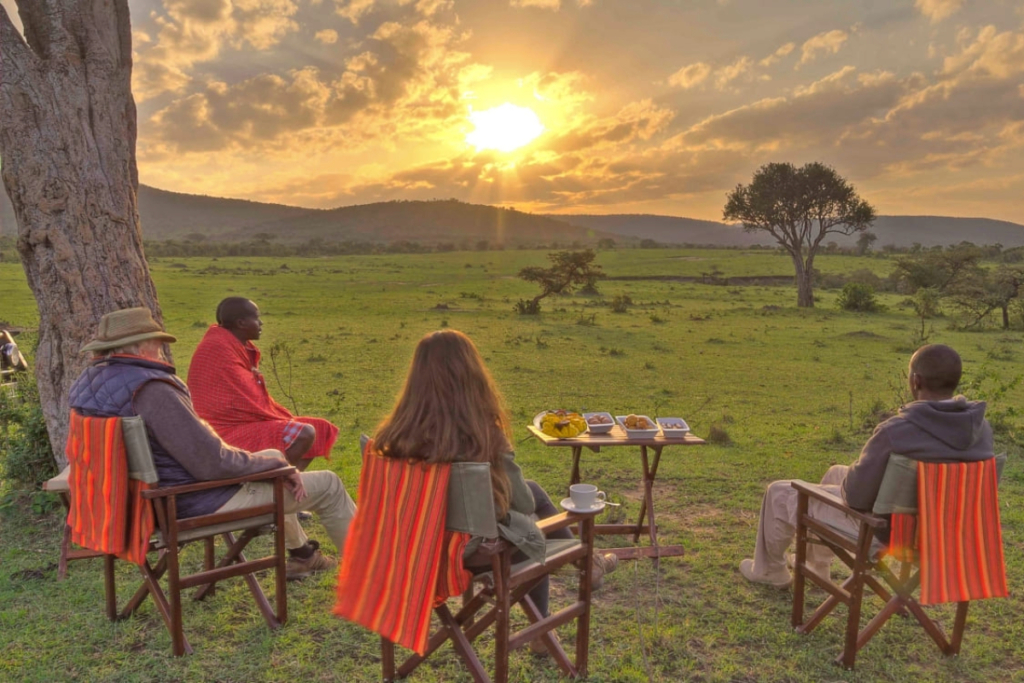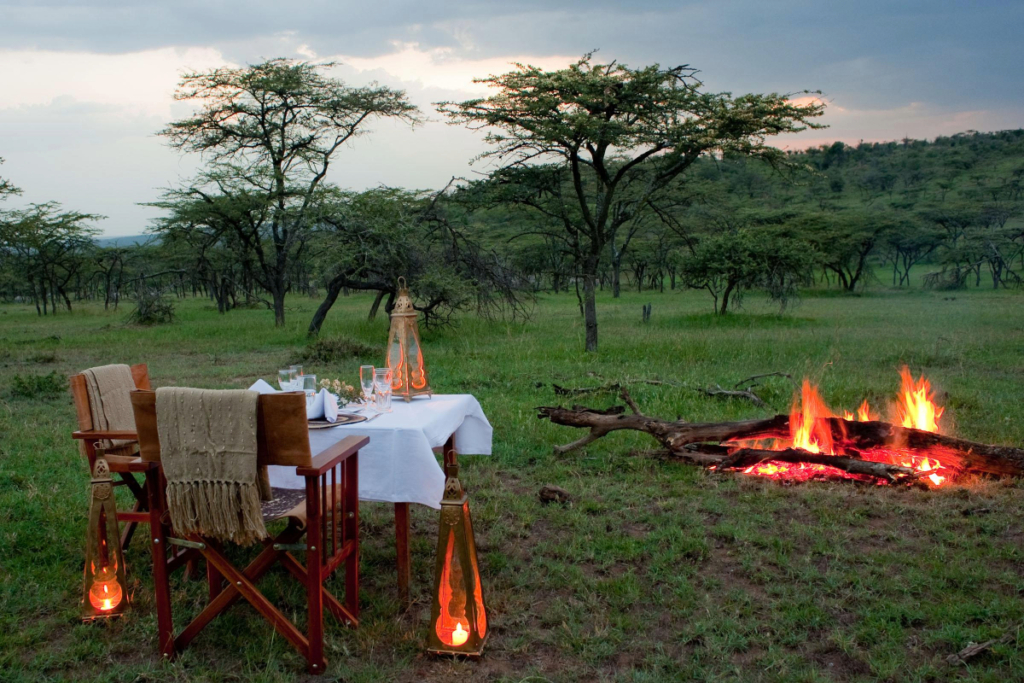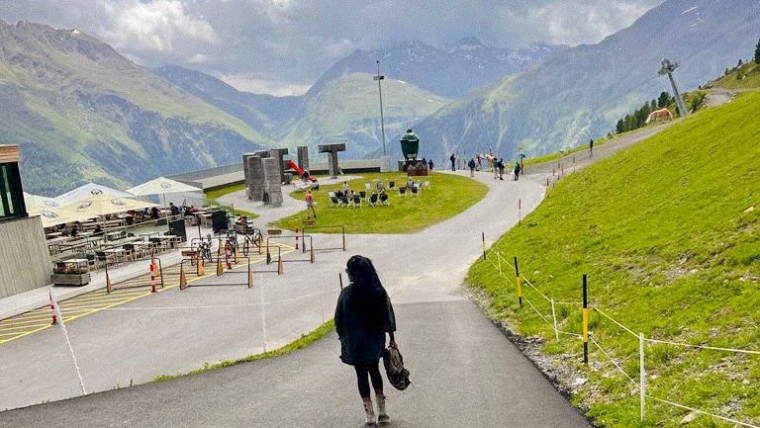From sunrise game drives to starlit dinners, keeping warm is key to enjoying every magical moment during an African safari.
Most people tend to imagine Africa as a place of endless sunshine and scorching heat, but if you’ve ever actually lived there, you know that that’s only a one-sided story. I grew up in Kenya, and some of my childhood memories are of those chilly early mornings walking to school. (Oh, how I hated those early mornings! ) I’d tuck my hands under my arms to keep warm, my breath visible in little clouds as frost crunched under my tiny shoes (bless). Then just a few hours later, boom, the sun would be blazing and I’d be peeling off my sweater, squinting against the harsh midday glare. And by evening? Again, the cold would creep back in fast, turning the air crisp and sharp as soon as the sun dipped behind the horizon.
Sound familiar? That’s exactly what being on an African Safari feels like. You’re up before dawn, probably wrapped in thick blankets in the back of an open game drive vehicle, watching the mist lift off the savannah as your breath fogs in the morning air. And by late morning, the layers come off as the sun climbs high and the heat sets in. Then, in the evening as the golden light of sunset fades, you’ll feel that familiar chill return. Quick and biting, just like in the morning.
But here’s the thing, though. Kenyans and anyone who’s spent enough time on safari know exactly how to handle these wild swings in temperature. And it all lies in being prepared, layering smart and knowing how to work with the rhythm of the day. So here’s how to do it right.
What You Should Wear On Safari
In Kenya (as in most East African countries), we take layering seriously. Locals know that the temperature can swing from freezing cold to blisteringly hot within a few short hours. With that in mind, most people tend to dress accordingly. The secret is starting with a solid base layer. Something lightweight and breathable like merino wool. Or, an insulated jacket that keeps the warmth locked in when you most need it, while a windproof outer layer saves you from the brutal chill of the early morning game drives.
The trick is not just piling on layers but making sure they’re easy to remove once the sun cranks up the heat. I mean, nothing ruins a perfectly good safari drive faster than being stuck sweating in a jacket you can’t quickly peel off. So, practicality here is key. I’d highly recommend choosing pieces that fold down small into your daypack and don’t overcomplicate things with heavy, hard-to-manage clothing. Trust me, you will thank yourself when you’re free to chase that perfect lion photo without feeling like a boiled potato.

Image: Kenya Tourism
Keeping Your Hands, Feet and Head Warm on Safari
It’s always the smallest part of you that goes numb first. One minute you’re absolutely feeling fine, the next you can’t even work your camera because your fingers are frozen stiff. Anyone who’s spent a cold morning on Safari knows the extremities are where the cold sneaks in first, and ignoring them might just be a rookie mistake.
A good pair of gloves, preferably the convertible ones that let you expose your fingers for quick photos without peeling the whole thing off, makes a world of a difference. If your feet are always cold like mine, wear some thick wool socks to keep your feet from turning into blocks of ice. And another key item I’d say you bring along? A beanie. Do not by any chance underestimate the power of a simple beanie. It might not be the height of glamour, but it fits neatly in your drive pack when it’s time to get rid of it.
So remember to protect those outer edges of your body properly if you want to be free to enjoy the magic unfolding around you without distraction.
The Maasai Shuka is the Ultimate Safari Blanket
If you spend even a few hours in Kenya or Tanzania, you’ll definitely spot the shuka everywhere. And it’s not just because they look fantastic in photos. The Maasai figured out a long time ago that a thick, lightweight woven wrap is the perfect answer to the wild changes of East African weather. These so-called “African blankets” are a masterclass in form meeting function at the same time.
Drape one over your shoulders while sipping your morning coffee at camp. I also like wrapping it around my legs to keep me warm and also to keep away those pesky insects/mosquitoes. Ocassionally, you could also use them as a makeshift pillow during a long afternoon siesta between drives. A Maasai shuka is therefore endlessly versatile, as you can see. It’s also easy to pack or throw over your day bag.
I would recommend buying one locally. As it would really support local artisans while also giving you a genuine slice of culture to take home. Plus, there’s just that something very satisfying about swapping a jacket for a piece of traditional African design that’s been tested by centuries of harsh conditions.
Hacks from Local African Safari Tour Guides
If you really want to stay warm on a Safari, follow the example of the guides – not entirely, though, because then you’ll look like one yourself. Anyway, these men and women have spent countless hours out in the elements, and they know exactly how to keep comfortable without letting it get in the way of the adventure.
Hot water bottles, for example, are a lifeline on cold mornings. And many loges will quietly offer them. And if they don’t quietly have them ready for your drives, feel free to ask. Another classic trick is carrying a small thermos flask filled with steaming chai or coffee. Also, wrapping your hands around a hot mug while the sun creeps over the horizon feels like an act of pure luxury when you’re bundled up in the chilly morning air.
And for that final extra touch of comfort while on an African Safari, nothing beats a neck gaiter or buff. Lightweight and easy to stash away, it can be pulled up over your nose and ears just when you need it most. It might seem like a small thing, but out in the bush, those little details make all the difference between just surviving the cold and actually enjoying the magic of it.

Image: Adumu Safaris
What to Wear to African Safari Dinners
I must say, bush dinners under the stars are one of Safaris’ most cherished and unforgettable experiences. But if you think you’ll be completely fine in the same breezy outfit you wore during the day, think again. As soon as the sun goes down, temperatures drop really fast. And that magical table lit by hurricane lanterns can quickly turn into a chilly endurance test if you’re not prepared.
So, before heading out, I suggest you layer up with a warm mid-layer you can easily slip on, and pack a pashmina or soft shawl in your bag. Not only does it add a bit of elegance to your evening outfit, it’s also a saviour once the night turns sharp. Stay away from sandals and wear closed-toe shoes. Otherwise, cold, damp grass underfoot can seriously dampen the mood. You do not want that!
Now, that said, nobody really warns you about this when you’re booking your well-deserved African safari. But the coldest moments on safari often turn out to be the ones you treasure most. And it’s not just because of the gorgeous golden light or the stillness that stretches across the plains. It’s because the animals know better than to strut about under a blazing sun. Early mornings and late afternoons are when they move, hunt, graze, and socialise — leaving the middle of the day for a sensible siesta in the shade. Frankly, who can blame them?
When you’re dressed right and ready for it, you don’t just survive the chill. You own it. While everyone else is huddling miserably under borrowed blankets, you’ll be the one wide-eyed and beaming, camera at the ready, soaking in every glorious second without a frozen toe in sight.


